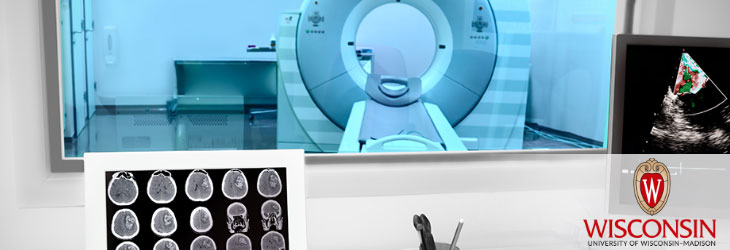Medical Imaging

Water-Fat Signal Separation for Improved MRI Image Reconstruction
WARF: P090389US01
Inventors: Scott Reeder, Huanzhou Yu
The Wisconsin Alumni Research Foundation (WARF) is seeking commercial partners interested in developing a method to improve MRI images by reducing water-fat signal swaps.
Overview
Chemical shift-based multi-echo water-fat separation methods are used increasingly in MRI clinical applications to distinguish between water and fat nuclear magnetic resonance (NMR) signals. Water and fat signals can be “swapped” by imaging algorithms due to shifts in the magnetic field that occur during imaging. A tumor mislabeled as fat in a particularly bad swap could lead to an incorrect diagnosis. Distinguishing between the signals is important for image quality and clarity, which contributes to accurate interpretation and diagnosis by clinicians.
Many current methods acquire signals from two or three “echoes,” each with different water-fat phase shifts, and use algorithms that simultaneously estimate and calculate the water and fat images. The fat and water signals are separated by correcting the magnetic field inconsistencies between signals. These methods reduce the number of water-fat swaps but do not alleviate them altogether, and are known to be error prone and sensitive to noise. Developing accurate algorithms for extremely robust water-fat separation is an ongoing challenge.
Many current methods acquire signals from two or three “echoes,” each with different water-fat phase shifts, and use algorithms that simultaneously estimate and calculate the water and fat images. The fat and water signals are separated by correcting the magnetic field inconsistencies between signals. These methods reduce the number of water-fat swaps but do not alleviate them altogether, and are known to be error prone and sensitive to noise. Developing accurate algorithms for extremely robust water-fat separation is an ongoing challenge.
The Invention
UW-Madison researchers have developed an algorithm for separating the nuclear magnetic resonance (NMR) signal contributions from at least two different species such as fat and water to improve image reconstruction methods. The process uses a field map constructed with an algorithm as the initial input. This initial map is used to generate weighting maps that indicate the likelihood of a water-fat swap at each pixel based on spectral differences and the local field map gradient at each pixel. Then the field map values for select pixels are recalculated based on the weighting maps. The process is repeated iteratively until the weighting maps indicate that no pixels should be recalculated. Images reconstructed using these algorithms are of substantially better quality with minimal water-fat swaps.
Applications
- Image reconstruction algorithms for MRI
- Chemical species combinations including water-fat, water-silicone-fat and others
Key Benefits
- Minimizes water-fat swapping in reconstructed magnetic resonance images
- Improves the quality of water-fat signal separation methods
- Enhances accuracy of patient diagnoses
Additional Information
For More Information About the Inventors
Tech Fields
For current licensing status, please contact Jeanine Burmania at [javascript protected email address] or 608-960-9846
Figures
